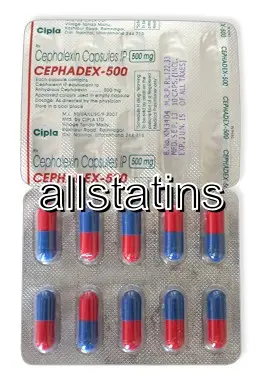Buy Cephalexin Online in Australia
| Package | Dosage | Price | Price per Dose | |
|---|---|---|---|---|
| Dosage: 500mg | ||||
| 270 pill | 500mg | AUD1,124.40 | AUD4.17 | |
| 180 pill | 500mg | AUD763.83 | AUD4.25 | |
| 120 pill | 500mg | AUD534.14 | AUD4.46 | |
| 90 pill | 500mg | AUD421.97 | AUD4.67 | |
| 60 pill | 500mg | AUD301.78 | AUD5.02 | |
| 30 pill | 500mg | AUD170.91 | AUD5.72 | |

Cephalexin Description
Overview of Cephalexin
Cephalexin is a widely used antibiotic belonging to the class of cephalosporins. It is effective against a broad range of bacterial infections, making it a common choice in both outpatient and inpatient settings. The medication works by interfering with the bacterial cell wall synthesis, ultimately leading to the death of the bacteria. Because of its proven effectiveness and safety profile, Cephalexin is often prescribed for skin infections, respiratory tract infections, ear infections, and urinary tract infections.
Mechanism of Action
Cephalexin inhibits bacterial cell wall synthesis by binding to penicillin-binding proteins (PBPs). This action prevents the cross-linking of peptidoglycan chains, which are essential components of the bacterial cell wall. Without a proper cell wall, bacteria become fragile and are unable to maintain their shape, leading to cell lysis and death. This bactericidal activity makes Cephalexin particularly effective against actively dividing bacteria.
Effectiveness and Spectrum
Cephalexin is effective mainly against Gram-positive bacteria, including Streptococcus species and some strains of Staphylococcus, including methicillin-sensitive Staphylococcus aureus (MSSA). Its activity against Gram-negative bacteria is more limited but includes certain organisms like Escherichia coli and Proteus mirabilis. This spectrum of activity makes Cephalexin suitable for treating a variety of common infections.
Dosage and Administration
The typical dose of Cephalexin varies depending on the infection's severity and the patient's age and weight. It is usually administered orally in the form of capsules or liquid suspension. Patients are advised to complete the full course of treatment even if symptoms improve before finishing the medication. This helps prevent the development of antibiotic-resistant bacteria and reduces the risk of infection recurrence. It is also recommended to take Cephalexin with a full glass of water and, if advised, with food to minimize gastrointestinal discomfort.
Potential Side Effects
Most patients tolerate Cephalexin well, but some may experience side effects. Common adverse reactions include gastrointestinal issues such as nausea, diarrhea, and stomach cramps. Allergic reactions are also possible, ranging from mild rash to severe cases like anaphylaxis. Other less common side effects include headache, dizziness, and skin rashes. Patients with a history of allergies to penicillins or cephalosporins should inform their healthcare provider before starting this medication.
Precautions and Interactions
Before taking Cephalexin, it is important to inform your healthcare provider about any allergies, existing medical conditions, or other medications you are using. While it is generally safe, it may interact with certain drugs such as anticoagulants, potentially affecting blood clotting. It is also necessary to complete the prescribed course, even if symptoms disappear, to ensure the infection is fully eradicated. If you experience severe allergic responses or worsening symptoms, seek medical assistance promptly.
Resilience and Resistance Concerns
The overuse and misuse of antibiotics like Cephalexin can lead to the development of resistant bacterial strains. Such resistance reduces the medication's effectiveness, making infections more difficult to treat. Therefore, it is critical to use Cephalexin only when prescribed by a healthcare professional and to adhere strictly to the recommended dosage and duration of treatment. Regular medical supervision helps ensure the best therapeutic outcomes and helps in reducing resistance issues.


